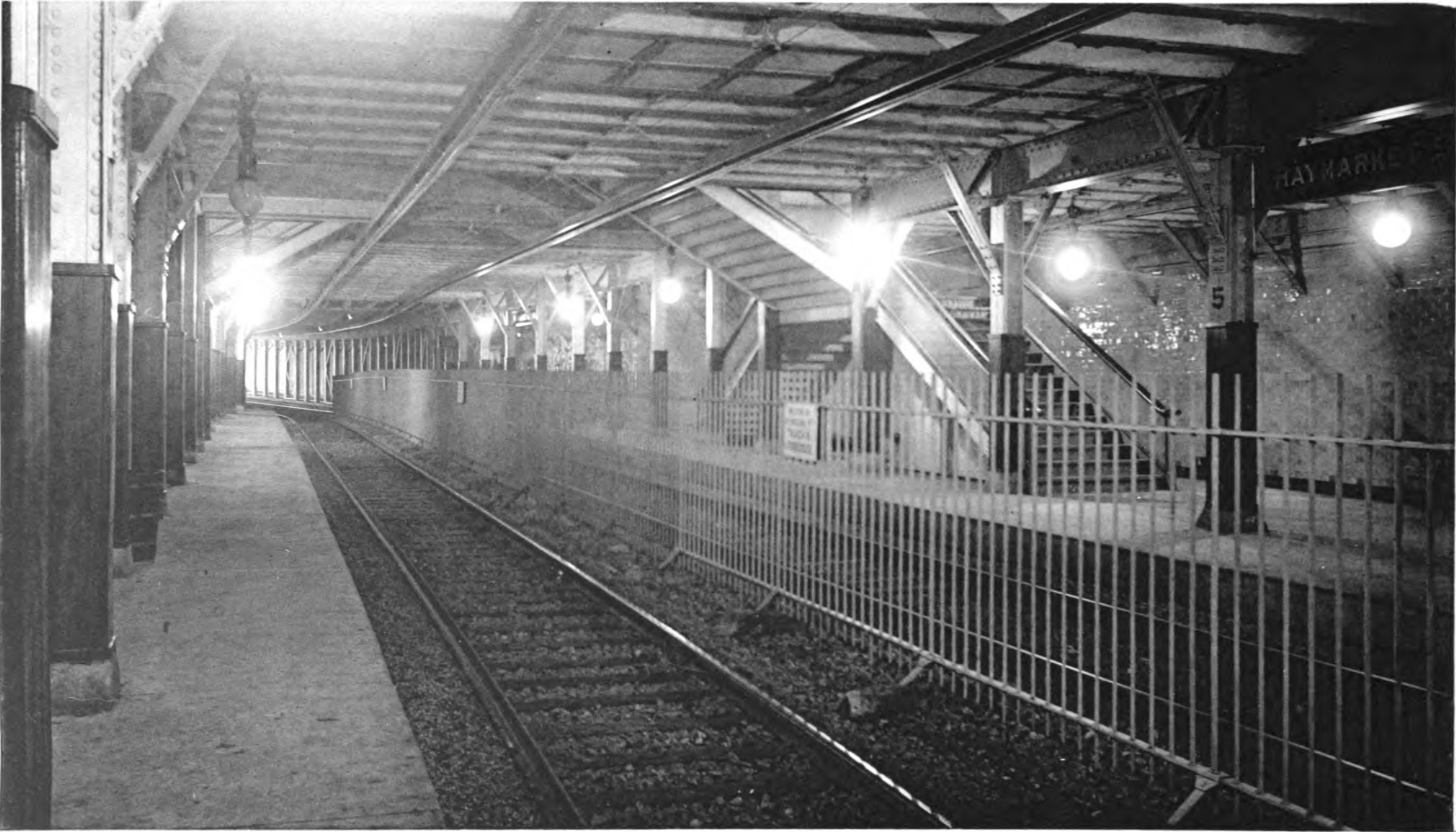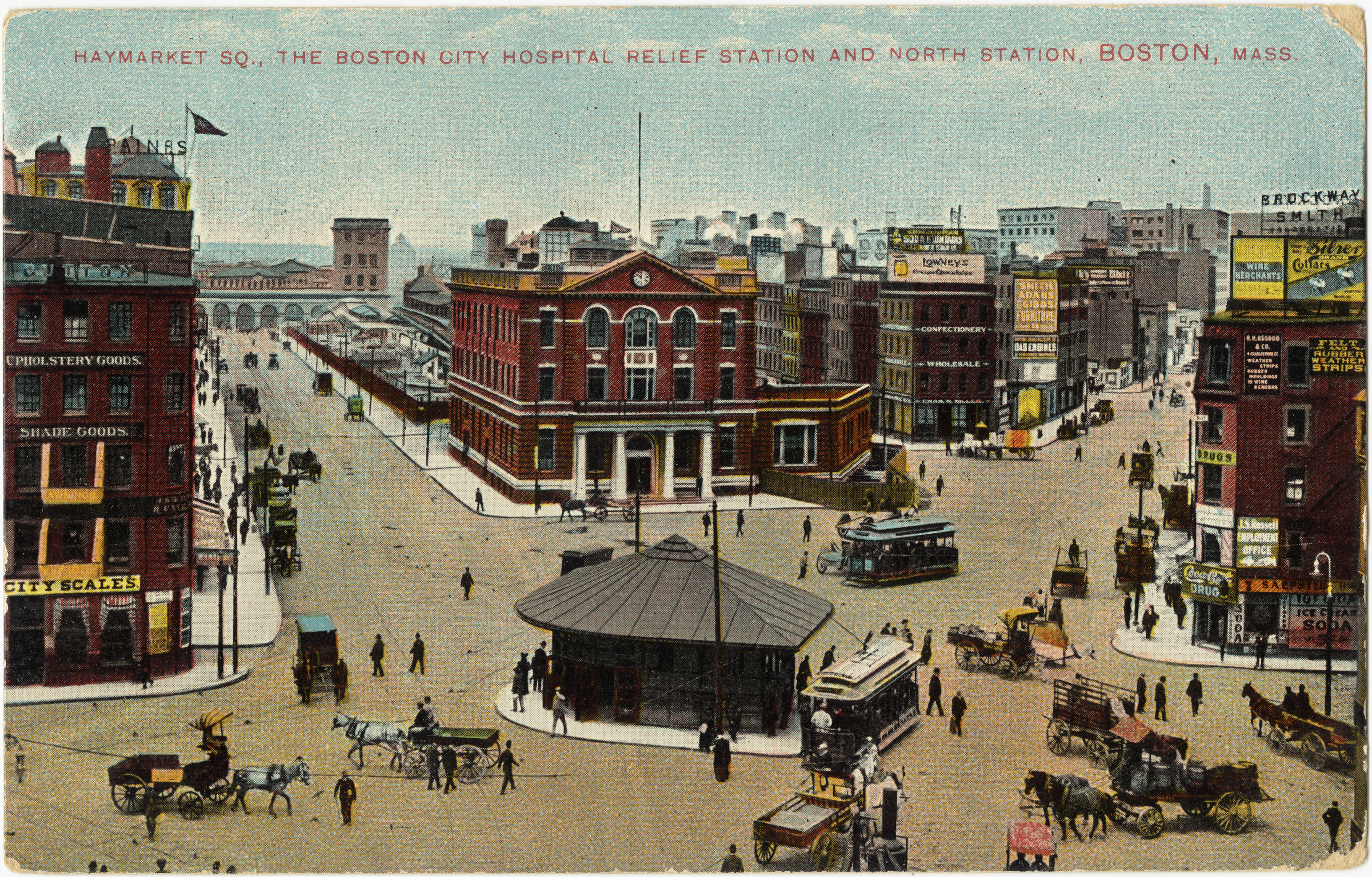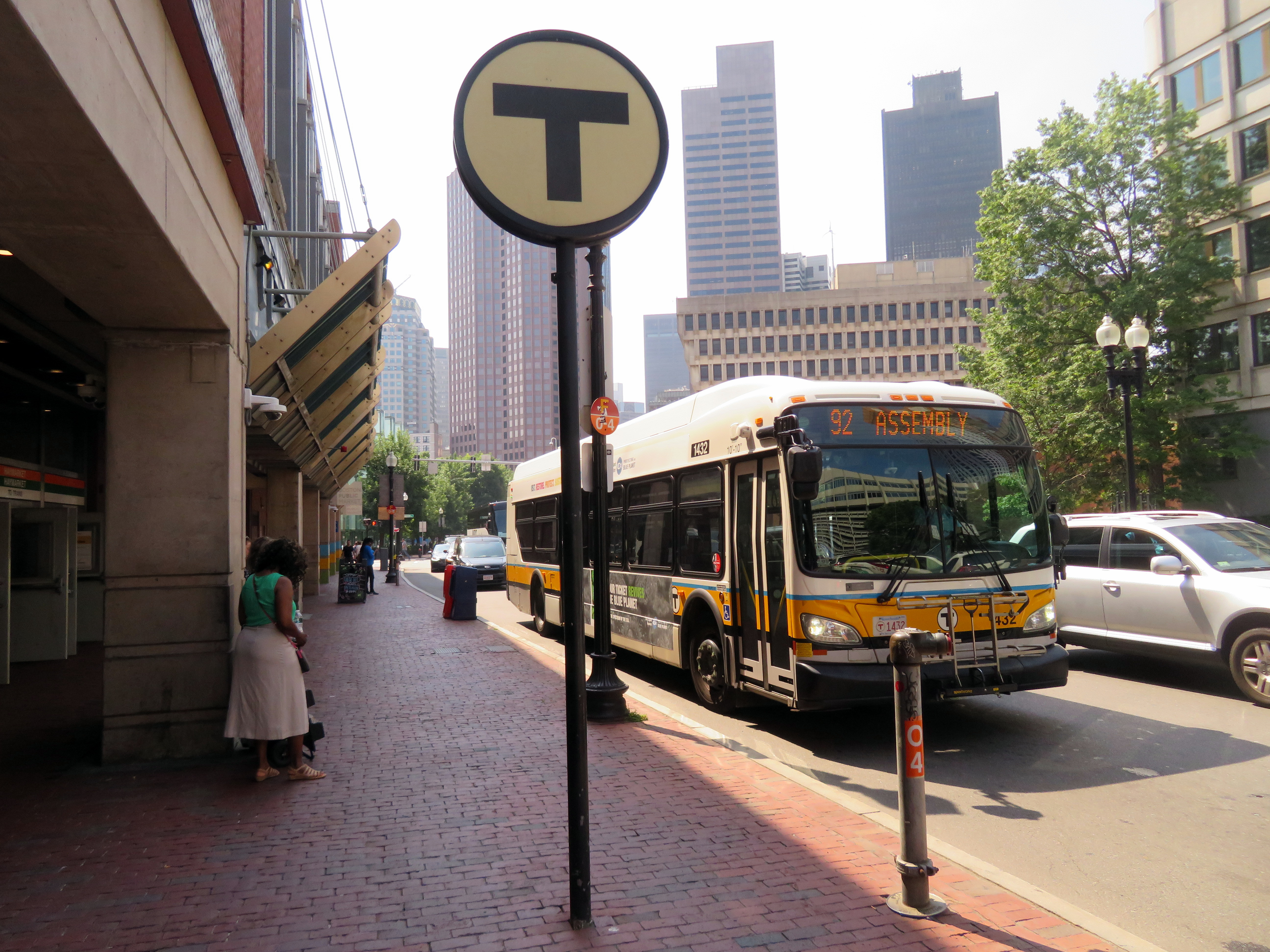Haymarket (MBTA station) on:
[Wikipedia]
[Google]
[Amazon]
Haymarket station is an underground



 On October 28, 1963, the tunnel between Haymarket and the newly renamed Government Center station was realigned, and Adams Square station was closed. The outer tracks at Haymarket now connected directly to the through tracks at Government Center, while the center tracks connected to Brattle Loop. On January 26, 1967, Union and Friend platforms were officially renamed Haymarket.
On May 10, 1971, the MBTA opened a new Green Line platform at Haymarket, located south (inbound) of the 1898-built station. The new island platform occupies the space of the former center tracks, which were reconnected to the through tracks just south of the new platform. The original 1898 platforms are still visible in the tunnel from Green Line cars traveling just north of the new platforms. The empty space is now used for electrical equipment and occasional storage. A new entrance and busway under the Government Center Garage opened on December 20, 1971. In August 1975, the MBTA released plans to modernize four downtown stations, including the Orange Line platforms at Haymarket.
The
On October 28, 1963, the tunnel between Haymarket and the newly renamed Government Center station was realigned, and Adams Square station was closed. The outer tracks at Haymarket now connected directly to the through tracks at Government Center, while the center tracks connected to Brattle Loop. On January 26, 1967, Union and Friend platforms were officially renamed Haymarket.
On May 10, 1971, the MBTA opened a new Green Line platform at Haymarket, located south (inbound) of the 1898-built station. The new island platform occupies the space of the former center tracks, which were reconnected to the through tracks just south of the new platform. The original 1898 platforms are still visible in the tunnel from Green Line cars traveling just north of the new platforms. The empty space is now used for electrical equipment and occasional storage. A new entrance and busway under the Government Center Garage opened on December 20, 1971. In August 1975, the MBTA released plans to modernize four downtown stations, including the Orange Line platforms at Haymarket.
The
 Because the Washington Street Tunnel was built to replace the Tremont Street subway for Main Line Elevated use – and to share the Canal Street incline – the Green Line and Orange Line are parallel and approximately the same depth at Haymarket. The Green Line, to the west of the Orange Line, has two tracks serving an
Because the Washington Street Tunnel was built to replace the Tremont Street subway for Main Line Elevated use – and to share the Canal Street incline – the Green Line and Orange Line are parallel and approximately the same depth at Haymarket. The Green Line, to the west of the Orange Line, has two tracks serving an

 Haymarket is a major bus transfer station, with a (presently closed) two-lane busway off Surface Road. Services from Haymarket include several local routes to Charlestown and Chelsea, as well as express buses to northern suburbs and the North Shore.
*: –Tide Street
*: –Downtown via Main Street
*: Sullivan Square Station–Downtown via Bunker Hill Street
*: Woodlawn–Haymarket station
*: Elm Street, Medford–Haymarket
*: West Medford–Haymarket
*: Burlington– State Street, Boston
*: Woburn–Downtown Boston
*: Central Square, Lynn–Haymarket station
*: Oaklandvale–Haymarket station
*: Main Street, Peabody–Haymarket station
*: Salem Depot–Haymarket station
Routes 4, 92, 93, 352, and 354 did not use the busway and instead stop on surrounding surface streets.
Haymarket is also the terminus for four bus routes each with a single early-morning run. These routes were created in September 1960 for fare collectors, but in September 1999 they were added to public timetables as well.
*: –Haymarket station
*: Cleary Square–Haymarket station
*: –Haymarket station
*: Clarendon Hill–Haymarket station
Haymarket is a major bus transfer station, with a (presently closed) two-lane busway off Surface Road. Services from Haymarket include several local routes to Charlestown and Chelsea, as well as express buses to northern suburbs and the North Shore.
*: –Tide Street
*: –Downtown via Main Street
*: Sullivan Square Station–Downtown via Bunker Hill Street
*: Woodlawn–Haymarket station
*: Elm Street, Medford–Haymarket
*: West Medford–Haymarket
*: Burlington– State Street, Boston
*: Woburn–Downtown Boston
*: Central Square, Lynn–Haymarket station
*: Oaklandvale–Haymarket station
*: Main Street, Peabody–Haymarket station
*: Salem Depot–Haymarket station
Routes 4, 92, 93, 352, and 354 did not use the busway and instead stop on surrounding surface streets.
Haymarket is also the terminus for four bus routes each with a single early-morning run. These routes were created in September 1960 for fare collectors, but in September 1999 they were added to public timetables as well.
*: –Haymarket station
*: Cleary Square–Haymarket station
*: –Haymarket station
*: Clarendon Hill–Haymarket station
MBTA – Haymarket
*Google Maps Street View
Congress Street headhouseSurface Road headhouse
{{MBTA Subway Stations 1908 establishments in Massachusetts Financial District, Boston Green Line (MBTA) stations Orange Line (MBTA) stations Railway stations located underground in Boston Railway stations in the United States opened in 1898 Railway stations in the United States opened in 1908 MBTA subway stations located underground
Massachusetts Bay Transportation Authority
The Massachusetts Bay Transportation Authority (abbreviated MBTA and known colloquially as "the T") is the public agency responsible for operating most public transportation services in Greater Boston, Massachusetts. The MBTA transit network ...
(MBTA) rapid transit station located at Haymarket Square Haymarket Square may refer to:
* Haymarket Square (Boston), in Boston
* Haymarket Square (Chicago), in Chicago
* Haymarket affair
The Haymarket affair, also known as the Haymarket massacre, the Haymarket riot, the Haymarket Square riot, or ...
in Boston, Massachusetts. It is a transfer station between the Green Line and Orange Line of the MBTA subway
The Massachusetts Bay Transportation Authority (MBTA) operates rapid transit (heavy rail), light rail, and bus rapid transit services in the Boston metropolitan area, collectively referred to as the rapid transit, subway, or the T system.
Th ...
system, as well as a terminal for MBTA bus
The Massachusetts Bay Transportation Authority (MBTA) operates 170 bus routes in the Greater Boston area. The MBTA has a policy objective to provide transit service within walking distance (defined as ) for all residents living in areas with po ...
routes serving northern and northeastern suburbs. The two lines run parallel to each other through the station, with two side platform
A side platform (also known as a marginal platform or a single-face platform) is a platform positioned to the side of one or more railway tracks or guideways at a railway station, tram stop, or transitway. A station having dual side platfo ...
s for the Orange Line and a single island platform
An island platform (also center platform, centre platform) is a station layout arrangement where a single platform is positioned between two tracks within a railway station, tram stop or transitway interchange. Island platforms are popular o ...
for the Green Line. The station is fully accessible
Accessibility is the design of products, devices, services, vehicles, or environments so as to be usable by people with disabilities. The concept of accessible design and practice of accessible development ensures both "direct access" (i. ...
.
The Tremont Street subway, predecessor of the modern Green Line, opened in 1898. It had a four-track streetcar station at Haymarket. The subway was also used by the Main Line, predecessor of the Green Line, from 1901 to 1908. The Main Line was rerouted into the Washington Street tunnel, with Union and Friend stations at Haymarket Square, in 1908. Union and Friend were renamed Haymarket in 1967. In 1971, the MBTA replaced the original Haymarket station with a new station slightly to the south. Demolition of a parking garage caused several closures of the station in 2021–22.
History


Tremont Street subway
The Tremont Street subway (future Green Line), including Haymarket, was built starting in 1894 and opened on September 3, 1898. The original trolley station was much more spacious than the current station, and consisted of four tracks with a pair ofisland platforms
An island platform (also center platform, centre platform) is a station layout arrangement where a single platform is positioned between two tracks within a railway station, tram stop or transitway interchange. Island platforms are popular on ...
. The inner pair of tracks served cars from the northern suburbs which turned at Brattle Loop at Scollay Square
300px, Scollay Square, Boston, 19th century (after September 1880)
350px, Scollay Square, Decoration Day, 19th century (after September 1880)
Scollay Square (c. 1838–1962) was a vibrant city square in downtown Boston, Massachusetts. It was na ...
(now Government Center) station, while the outer tracks served streetcars that ran through the entire Tremont Street subway to the Public Gardens portal and Pleasant Street portal. All cars entered the subway through the Canal Street incline
The Canal Street incline (also Canal Street portal) was a ramp connecting two transit tunnels in Boston with surface and elevated lines. It was located in the Bulfinch Triangle between North Station and Haymarket Square in two blocks bounded by Ca ...
just north of Haymarket.
Main Line Elevated
On June 10, 1901, theBoston Elevated Railway
The Boston Elevated Railway (BERy) was a streetcar and rapid transit railroad operated on, above, and below, the streets of Boston, Massachusetts and surrounding communities. Founded in 1894, it eventually acquired the West End Street Rai ...
's Main Line (future Orange Line) was opened from to . The Tremont Street subway was retrofitted to allow operation of the Main Line elevated cars. Main Line trains from the Charlestown Elevated entered the tunnel through the outer tracks of the Canal Street portal and exited through the Pleasant Street portal to the Washington Street Elevated
The Washington Street Elevated was an elevated segment of Boston's Massachusetts Bay Transportation Authority subway system, comprising the southern stretch of the Orange Line. It ran from Chinatown through the South End and Roxbury, ending i ...
. Elevated cars ran on the outer tracks at Haymarket, served by temporary high platforms; streetcars continued to use the inner tracks, which connected to a turnback loop at Adams Square station.
On November 30, 1908, a new Washington Street Tunnel opened for use by Main Line trains, and the whole Tremont Street subway was returned to streetcar use. The Washington Street Tunnel ran separately from the Tremont Street subway; however, because both tunnels used the newly expanded Canal Street incline, the Main Line platforms at Haymarket Square were immediately adjacent to the Tremont Street subway. Like the other Washington Street Tunnel stations, the two Main Line platforms were named after nearby streets. The northbound platform was Union and the southbound platform Friend – collectively called, Union–Friend.
The track configuration at Haymarket after 1908 was similar to the original 1898 setup – the outer tracks served streetcars running through the subway, while the center tracks served cars turning at Brattle Loop at Scollay Square
300px, Scollay Square, Boston, 19th century (after September 1880)
350px, Scollay Square, Decoration Day, 19th century (after September 1880)
Scollay Square (c. 1838–1962) was a vibrant city square in downtown Boston, Massachusetts. It was na ...
. The last (route #93) streetcars to use the inner tracks ran on July 2, 1949, although a North Station to Scollay Square shuttle ran until September 1952. After that, only emergency and special service cars used the inner tracks.
MBTA era
Haymarket North Extension
The Haymarket North Extension is a section of the Massachusetts Bay Transportation Authority's rapid transit Orange Line which currently constitutes the northern section of the line. It runs from North Station through an underground crossing of t ...
opened on April 7, 1975, replacing the Charlestown Elevated. North of Haymarket, the Orange Line tracks were redirected from the Canal Street incline into a new tunnel to North Station, and then under the Charles River. In June 2004, the Green Line was similarly rerouted, with the Canal Street incline closing entirely in favor of a tunnel to a newly rebuilt "superstation" at North Station. That spacious new facility allows convenient cross-platform transfer
A cross-platform interchange is a type of Interchange station, interchange between different lines at a rapid transit, metro (or other railway) station. The term originates with the London Underground; such layouts exist in other networks but ar ...
s between the inbound Green and Orange Lines, as well as full outbound connections, lessening the importance of Haymarket as a rail transfer station. However, Haymarket station remains a major bus transfer station, served by many routes.
Renovations
A 2000–01 renovation, part of the Parcel 7 construction, added elevators to all levels of Haymarket. This made the Orange Line accessible at the station. A $15 million project to build raised platforms at and Haymarket began in 2001 and was completed by 2003. On June 24, 2019, the MBTA Board awarded a $29.7 million, 16-month contract for full cleaning, wayfinding signage replacement, and other improvements atNorth Station
North Station is a commuter rail and intercity rail terminal station in Boston, Massachusetts. It is served by four MBTA Commuter Rail lines – the Fitchburg Line, Haverhill Line, Lowell Line, and Newburyport/Rockport Line – and the Amtrak ...
, Haymarket, State
State may refer to:
Arts, entertainment, and media Literature
* ''State Magazine'', a monthly magazine published by the U.S. Department of State
* ''The State'' (newspaper), a daily newspaper in Columbia, South Carolina, United States
* ''Our S ...
, and Downtown Crossing
Downtown Crossing is a shopping district within downtown Boston, Massachusetts, located east of Boston Common, west of the Financial District, south of Government Center, and north of Chinatown and the old Combat Zone. It features la ...
stations. Much of the cosmetic work at Haymarket, including painting and floor repairs, was completed over the weekend of August 30–September 1, 2019. The work was completed in June 2021.
Part of the Bulfinch Crossing development will be built over the busway in the early 2020s; the project will include a modernization of the Green Line entrance and the busway. A temporary closure of the station during construction was originally considered; the developer later agreed to keep the station open, though temporary closures of the north headhouse may be needed. By February 2020, the section of the garage above the station was planned to be demolished in December 2020; however, this was delayed by the COVID-19 pandemic.
The busway closed on June 28, 2021, with buses stopping on nearby streets. Demolition of the garage required several weekend closures of portions of the Green and Orange lines, as well as a weekend closure of just the station, in early 2022. Construction of the development and the new busway is expected to take 36 months.
After a portion of the garage collapsed on March 26, 2022, Orange Line and Green Line service through the station was temporarily suspended pending inspection of the tunnels. Orange Line service resumed on March 29, with trains bypassing Haymarket. After removal of about of debris followed by tunnel inspection and testing, Green Line service resumed on April 9, with Haymarket station remaining closed for repairs to the standpipe system. The station reopened on April 10. The Orange and Green lines were again closed through Haymarket from June 23–26, 2022, after the discovery of a deteriorated garage support column.
The station was closed in August and September 2022 during overlapping closures of the Orange Line (August 19 to September 18) and the northern portion of the Green Line (August 22 to September 18). The closures allowed for maintenance work as well as further demolition of the garage.
Station layout
island platform
An island platform (also center platform, centre platform) is a station layout arrangement where a single platform is positioned between two tracks within a railway station, tram stop or transitway interchange. Island platforms are popular o ...
divided in half by a wall. The Orange Line has two tracks serving two side platform
A side platform (also known as a marginal platform or a single-face platform) is a platform positioned to the side of one or more railway tracks or guideways at a railway station, tram stop, or transitway. A station having dual side platfo ...
s. A sub-passage at the north end of the platforms allows transfer between the two lines.
The two lines have separate primary entrances, although the sub-passage allows both lines to be reached from either entrance. The Green Line entrance is located north of Sudbury Street, under the east end of the Government Center Garage. It is adjacent to a two-lane busway off Surface Road, which can be reached by buses using the Sumner and Callahan tunnels or North Washington Street. The Green Line fare lobby is level with the platform. The Orange Line entrance is inside the Boston Public Market
The Boston Public Market is an indoor public market that opened in July 2015 in downtown Boston, adjacent to the Rose Fitzgerald Kennedy Greenway. The market houses more than 35 year-round vendor stalls, and is open seven days a week. An outdoo ...
building south of Sudbury Street. A mezzanine level is between the street-level fare lobby and the platforms.
Two elevators connect the Orange Line entrance to the two platforms, and another pair connect the platforms to the sub-passage. An elevator connects the Green Line entrance to the fare lobby, and the Green Line platform to the sub-passage.
Bus connections
References
External links
MBTA – Haymarket
*Google Maps Street View
Congress Street headhouse
{{MBTA Subway Stations 1908 establishments in Massachusetts Financial District, Boston Green Line (MBTA) stations Orange Line (MBTA) stations Railway stations located underground in Boston Railway stations in the United States opened in 1898 Railway stations in the United States opened in 1908 MBTA subway stations located underground